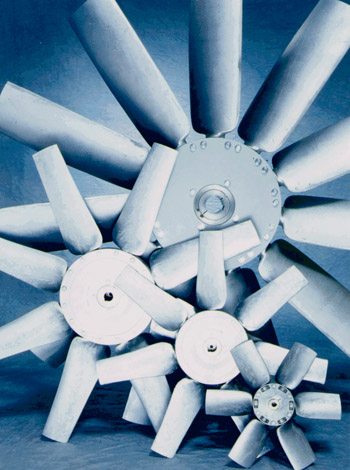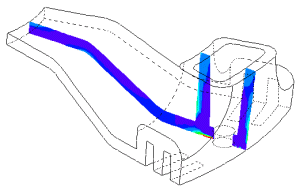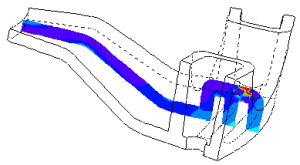Case Study
Design optimisation of
an axial impeller hub
Air Radiators Pty Ltd of Geelong, Australia - now part of the Austrim
group of companies, used LUSAS finite element analysis to minimise weight, increase
strength and minimise the cost of their high grade aluminium alloy mid diameter industrial
axial impeller. The impeller varies from 700mm to 1100mm diameter and operates at speeds
ranging from 720 to 2880 rpm.
| The fans are used extensively in commercial and
industrial installations where large air volumes have to be moved. Operating conditions
vary from extremes of temperature in applications such as blast freezers and smoke spill
fans to the highly corrosive environments encountered in brick drying kilns. Other
installations range from general air-conditioning, air blast heat exchangers and air
extraction systems. The new hub design was required to satisfy all current operating
conditions and in addition, cut manufacturing costs and improve product quality. To
achieve this, the number of parts in the assembly was reduced from 27 to 2, rationalising
tooling and reducing assembly times.
LUSAS was used to analyse the existing hub and determine the
stresses and displacements in both this design and a new proposed design. Model data was
imported using the LUSAS CAD Toolkit. Due to the complexity of the geometry, a full 3
dimensional analysis was needed using 3D parabolic brick elements. A comprehensive linear
stress analysis was carried out for a range of loads such as radial blade loading, bolt
clamping forces, bending moments induced by impeller air pressure development and
centrifugal forces. These load cases were combined using the Load Combination facility in
LUSAS.
The results focused design efforts in the areas of the
hub that showed the highest stress levels and also enabled the designer to meet the
stringent dimensional and cross-sectional restraints of the pressure die casting process.
The analysis also provided the designers with a comparison of the stresses between the new
and existing fan designs, giving a level of confidence in the final design. Using LUSAS
for this analysis has saved Air Radiators Pty Ltd time and money building and testing
physical prototypes. |

|
|

|

|
Air Radiators are now
considering automating the whole analysis process for their entire range of fans by using
the parametric command facility in LUSAS. Using this facility, engineers can generate
prompting menus for use during the input of model and design data, and automate the
geometry generation, meshing and loadcase assignment for components of similar shape. The
parametric command language can also generate results plots and graphs for reports that
are consistent and comprehensive. As the parametric approach builds-in the expert
knowledge of the FE analyst, Air Radiators Pty Ltd can use this feature as a way of
retaining accumulated expertise whilst permitting junior engineers to run many "what
if" trials to a consistent QA standard.
Other LUSAS Analyst case
studies:
|
|
Software Information
|